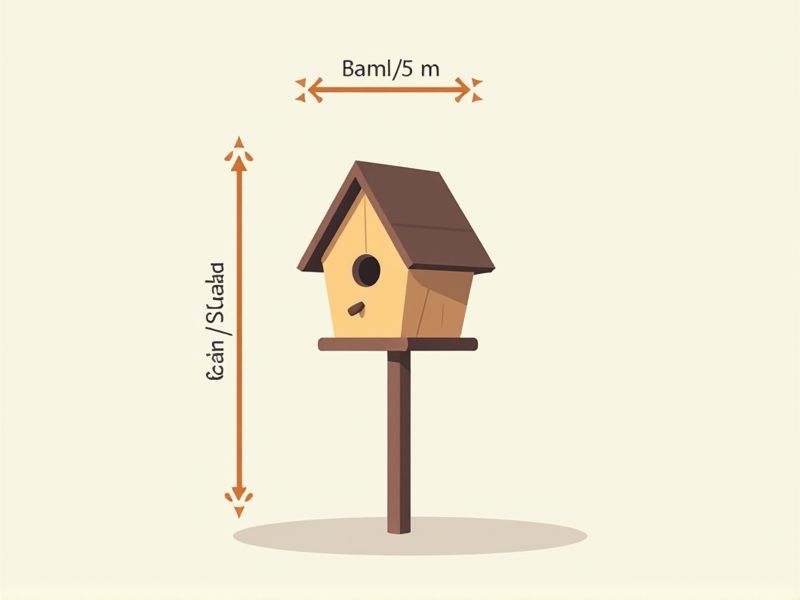
When building a birdhouse, choosing the right dimensions is essential for attracting your intended bird species and ensuring their safety. A common standard for small songbirds, like chickadees or wrens, is an interior floor space of about 4 by 4 inches (10 by 10 cm), with a height of roughly 8 inches (20 cm). The entrance hole should generally be 1 1/8 inches (2.8 cm) in diameter and placed about 6 inches (15 cm) above the floor to keep chicks safe from predators. Ensuring the birdhouse is well-ventilated and easy to clean will also contribute greatly to the health and comfort of its inhabitants.
Interior Cavity Size
An ideal birdhouse should have an interior cavity size of 6 to 12 inches deep, accommodating various bird species. This depth allows for sufficient nesting space, while the entrance hole should measure approximately 1.25 to 1.5 inches in diameter to keep larger predators out. The interior should be roughened or include wood shavings to provide birds with traction and comfort during nesting. Regular cleaning and maintenance ensure that your birdhouse remains conducive for re-nesting and provides a safe haven for local wildlife.
Entrance Hole Diameter
The entrance hole diameter for birdhouses should ideally measure between 1.25 to 2 inches, depending on the bird species you want to attract. For example, a hole of 1.25 inches is perfect for smaller birds like bluebirds, while a 1.5-inch diameter can accommodate house wrens. Larger birds, such as American robins, may require a 2-inch entrance hole. Ensuring the correct size not only helps in attracting specific species but also protects them from predators.
Distance From Floor To Hole
The standard height for a birdhouse entrance hole should be approximately 6 to 10 inches from the floor of the house, depending on the species you aim to attract. For example, cavity-nesting birds like chickadees prefer a 6 to 8-inch distance, while bluebirds benefit from a slightly higher entrance hole setup at around 10 inches. Ensuring this optimal height not only facilitates easy access for the birds but also provides protection against predators. By adhering to these measurements, you significantly enhance the likelihood of successful nesting within your birdhouse.
Roof Overhang Length
The roof overhang length of a birdhouse should ideally measure between 2 to 4 inches, providing essential protection against rain and sun. This overhang helps shield the entrance, ensuring that fledglings remain dry and safe from predators. A longer overhang can also enhance insulation by reducing temperature fluctuations inside the birdhouse. Ensuring this standard can significantly improve the chances of attracting various bird species, as they seek suitable nesting environments.
Wall Thickness
The standard wall thickness for a birdhouse typically ranges from 3/4 inch to 1 inch, providing sufficient insulation and protection. A thickness of at least 3/4 inch helps to regulate temperature and shields fledglings from harsh weather conditions. Using durable wood types, like cedar or pine, further enhances the structure's longevity and resistance to the elements. Consider that the choice of wall thickness can significantly impact nesting success, as you aim to create a safe habitat for your feathered friends.
Floor Drainage Holes
A high-quality birdhouse typically includes floor drainage holes, which are essential for maintaining a dry environment inside. These holes prevent water accumulation, reducing the risk of mold and ensuring the health of the birds. Ideally, each drainage hole should measure about 1/4 inch in diameter, allowing excess moisture to escape while keeping predators out. By ensuring proper drainage, your birdhouse can support nesting birds and promote successful brooding throughout the season.
Ventilation Openings
Ventilation openings are crucial for maintaining optimal living conditions inside a birdhouse, ensuring air circulation and temperature regulation. Ideally, these openings should account for about 10-20% of the total surface area to effectively promote airflow. Positioning them near the top of the birdhouse can prevent moisture buildup, which can lead to mold and health issues for nesting birds. Incorporating adjustable vents allows you to adapt to seasonal changes, enhancing the comfort and safety of your feathered visitors.
Overall Height
The ideal overall height for a birdhouse typically ranges from 6 to 12 inches, catering to various bird species. Maintaining this height ensures easy access for birds while providing safety from predators. When creating your birdhouse, consider incorporating a 1.5-inch diameter entrance hole, which is suitable for many common backyard birds. Furthermore, a sloped roof enhances drainage and ventilation, contributing to the longevity and functionality of the birdhouse.
Mounting Hole Placement
The optimal mounting hole placement for a birdhouse is generally recommended to be between 1.5 to 2 inches in diameter, ensuring accessibility for various bird species. Positioning the entrance hole about 6 to 8 inches above the floor of the birdhouse promotes safety and shelter for nesting birds. Additionally, installing the birdhouse at a height of 5 to 10 feet helps protect against predators while providing birds a safe haven. Ensuring that the birdhouse is mounted in a sheltered location with minimal disturbance can significantly increase its appeal to birds seeking nesting sites.
Depth From Back Wall To Hole
The standard birdhouse design emphasizes a depth of 6 to 8 inches from the back wall to the entrance hole, facilitating optimal nesting conditions. This depth ensures that birds remain protected from predators while providing adequate space for their young. The diameter of the entrance hole typically measures between 1.25 to 2 inches, depending on the species of bird you aim to attract. Ensuring proper dimensions enhances the overall usability and safety of the birdhouse, ultimately encouraging successful nesting.
